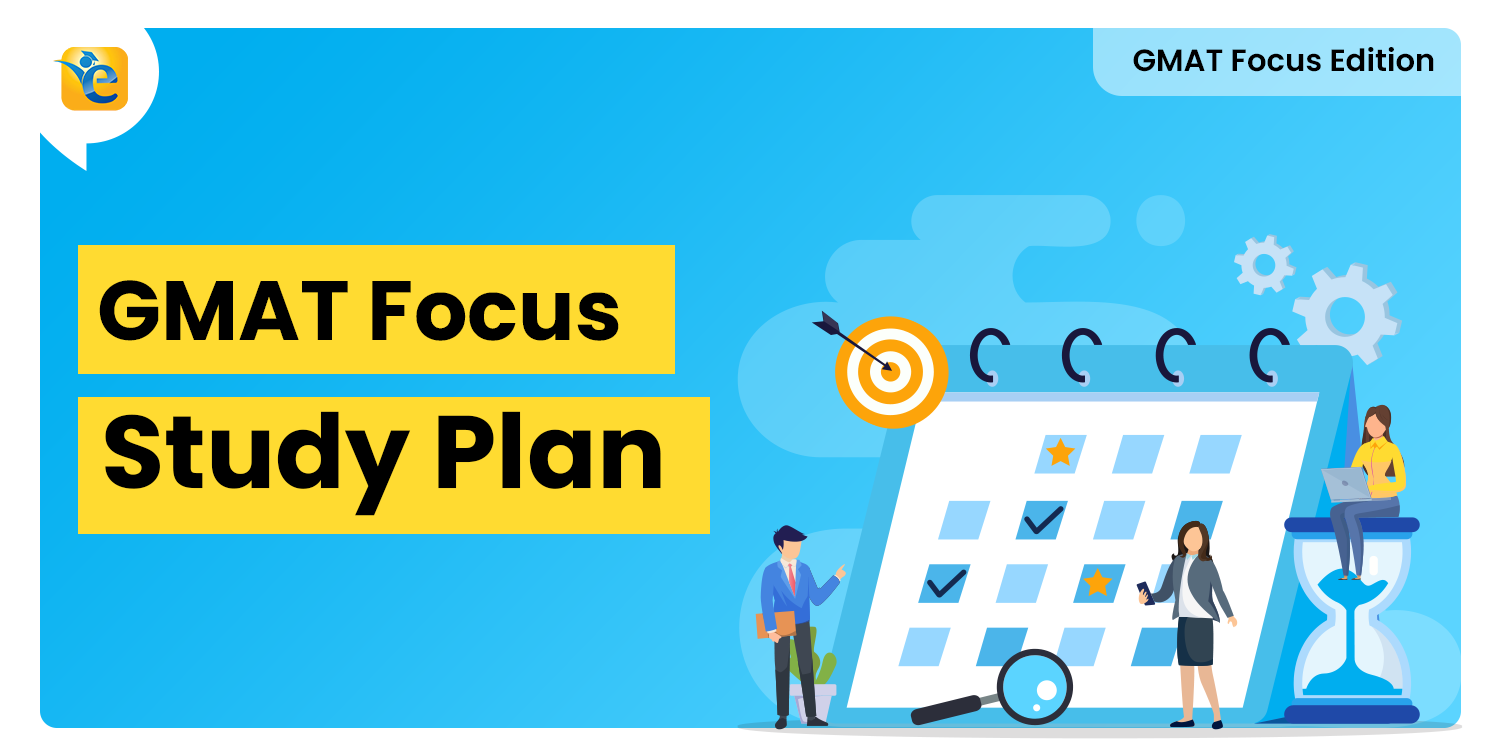“My Reading Comprehension scores were always strong, but those back-to-back passages destroyed my confidence mid-test and impacted my verbal score.”
In the past month, I’ve heard this concern repeatedly from a lot of students who are facing an unexpected challenge: clusters of 3-4 Reading Comprehension passages appearing consecutively in their exams.
As we know, traditionally, the verbal section had a mix of CR and RC questions distributed throughout the exam. But the past month has seen a notable shift from this familiar pattern, with all the RC passages now appearing in clusters mid-test, sandwiched between CR questions. This change has sparked anxiety among students, with many wondering if their preparation strategies need to be completely overhauled.
Why Is This Challenging?
This change in pattern creates three key challenges:
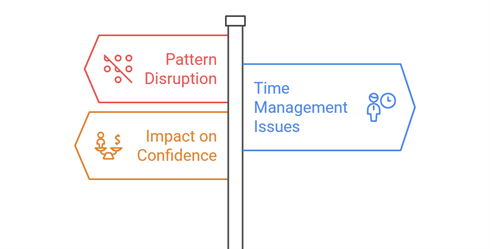
The Pattern Disruption:
You’ve trained with mixed question sets – alternating between CR and RC. When suddenly faced with multiple RC passages, it feels like running a sprint in the middle of your marathon. You’re forced to use the same mental muscles repeatedly without the usual “breaks” from switching between question types.
Time Management gets tricky:
Your timing strategy expects a mix: of 2 minutes for CR questions and 6-7 minutes for RC passages. Now imagine hitting a 20–25-minute block of just RC passages mid-test. Even the most well-practiced timing strategy gets thrown off balance.
The Confidence Challenge:
Even with strong skills in both CR and RC, facing unexpected back-to-back RC passages can trigger anxiety. It’s like preparing for a balanced workout, only to be told to do all your heavy lifting at once. Your confidence might waver, even though your abilities haven’t changed.
Now, here’s the thing – this change in pattern shouldn’t impact your score if you’re well-prepared.
Think about it – if your RC skills are strong, then whether you get RC passages spread out or bunched together shouldn’t matter. The same goes for CR. Your ability to analyze arguments or comprehend passages doesn’t change just because of their order. Moreover, the total number of questions for RC or for that matter CR does not change regardless of the clustering of RCs.
Let me prove this to you with a real case study.
Let us look at a real example
Recently, Maria encountered a similar situation – multiple RC passages back-to-back. The score – V79 – wasn’t what they were hoping for, and initially, she blamed it on the RC clustering.
Let’s analyze what really happened.
Here is the score report –
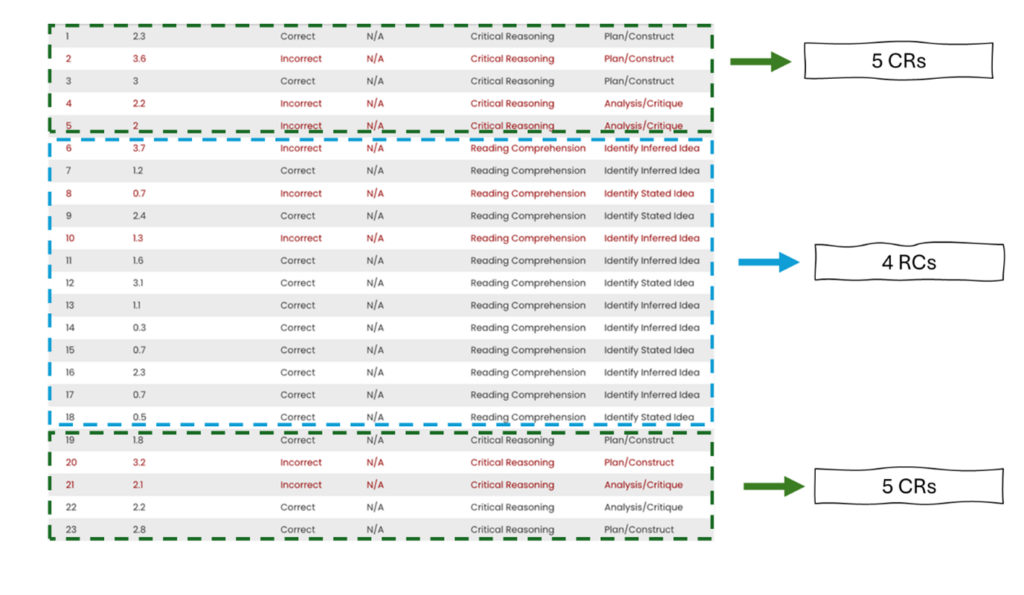
Here’s Her Score Report Pattern:
- First block: 5 CR questions
- Middle block: 4 back-to-back RC passages
- Final block: 5 CR questions
Let’s Look at Her Sub-sectional Percentiles:
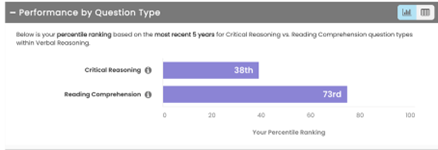
Interesting pattern, isn’t it? The key questions here are:
Her RC percentile is 73 – not bad, but could the clustering have prevented her from scoring even higher? And with CR showing lower performance, was this also impacted by the RC cluster? These are the key questions we need to answer.
Let’s Dig Deeper Looking at her performance:
- In RC: She scored at the 73rd percentile – good, but was this her true potential?
- In CR: Of the last 5 CRs, she got 2 wrong – was this due to fatigue from the RC cluster?
But before we jump to conclusions about the RC clustering affecting either score, let’s look at her practice stats:
Hard Accuracy Chart of Maria:
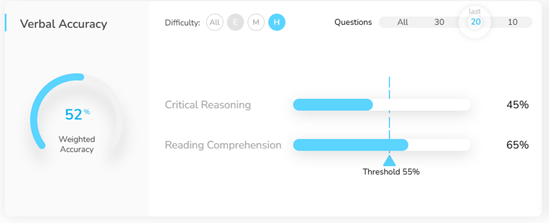
As per this chart, here are her ability levels:
| Sub-Section | Hard Accuracy | Percentile Ability Estimation |
| Critical Reasoning | 45% | 50th Percentile |
| Reading Comprehension | 65% | 89th Percentile |
Here’s the Reality Check: The sub-sectional percentiles on her actual test almost perfectly match her predicted ability levels. This tells us something crucial – despite the back-to-back RCs, Maria performed exactly at her expected level in both sections.
The Key Takeaway: If your verbal abilities are strong before test day, back-to-back passages won’t derail your performance. Your fundamental skills remain constant, regardless of question order.
Preparing for the Unexpected:
We’ve established that back-to-back RCs shouldn’t impact your score if your fundamentals are strong. But how do you build that level of preparation? Let me share three critical aspects of preparation that will help you tackle any question pattern with confidence.

Know Your Target Metrics:
Here’s what your accuracy should look like at different score targets:
| Accuracy on Hard Questions | Percentile Ability |
| 40% | 50%ile |
| 50% | 60%ile |
| 55% | 70%ile |
| 60% | 80%ile |
| 65% | 87%ile |
| 70% | 90%ile |
| 75% | 95%ile |
| 80% | 98%ile |
| 85% | 99%ile |
Both your CR and RC metrics need to meet these thresholds. There’s no workaround – if you’re aiming for 90th percentile or higher score in verbal, you need to be hitting those accuracy levels consistently.
Fix Those Hidden Weaknesses
Here’s a trap many students fall into: “My overall verbal accuracy is 70%, I’m good to go!” But dig deeper:
- What if your Strengthen questions are only at 55%?
- What if your RC inference questions drop to 40% on hard passages?
These pockets of weakness can surface at the worst times. You need to:
- Track your accuracy by question type
- Identify any sub-types below your target level
- Focus practice on these specific areas
Build Your Stamina:
Create practice sets, using custom quizzes that mirror the new reality:
- Set up 11 CR questions (mix of medium and hard)
- Immediately follow with 4 RC passages (medium and hard) – prepare with 4-5 RCs at a stretch, so that you are not flabbergasted if this happens on the actual exam.
- Time yourself under test conditions
At e-GMAT, our students are used to attempting back-to-back RCs through the process of cementing that prepares our students for RC clustering.
This isn’t just about accuracy – it’s about maintaining your focus and timing when the questions aren’t alternating.
The Bottom Line
At the end of the day, your GMAT score reflects your abilities, not the order of questions. As we saw with Maria’s case, her performance aligned perfectly with her practice levels – both in RC and CR. The clustering of RC passages didn’t change her fundamental abilities.
Yes, the GMAT is throwing curveballs – whether it’s back-to-back RC passages or consecutive Multi-Source Reasoning questions. But here’s what matters: if you’ve built strong fundamentals and prepared using the strategies we discussed, you’re ready for any pattern the test presents. Your ability to analyze arguments, comprehend passages, or reason across multiple sources doesn’t change just because of their order.
Remember – the GMAT is testing your skills, not your ability to predict question patterns. Focus on building those skills, prepare for various scenarios, and you’ll be ready to tackle whatever comes your way on test day.
Are you planning to pursue MBA at top business schools? Let us help you conquer the first step of the process i.e., taking the GMAT. Take a free mock test to understand your baseline score and start your GMAT prep with our free trial. We are the most reviewed online GMAT Prep company with 2800+ reviews on GMATClub.


